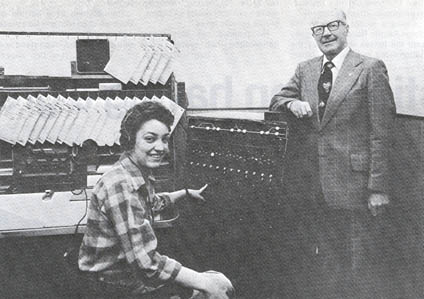
Public Relations and Advertising
Department
Windsor Station Montreal Que. H3C 3E4
|
Volume
7 Number 13
|
Oct. 12,
1977
|
Veteran Machine Still Good as
Ever
By
Beth Raugust

CP Rail's Centralized Traffic
Control console at Medicine Hat has chalked up as many years service as the age
difference between two of its many dispatchers over the past half century.
Twenty-one-year old Lynne Smith gets ready to flip a switch while
Desmond J. O'Coffey, retired CTC operator, watches.
Medicine Hat - Almost 50 years old
and still operating as smoothly as it did in its heyday... that describes CP Rail's
Centralized Traffic Control console in Medicine Hat which went into operation in 1928.
The machine controls three switches and associated signals on 7.1 miles of track on
the Maple Creek Subdivision from Medicine Hat eastward where 12 scheduled freight and
passenger trains pass through each day.
Until the inception of CTC, all train traffic had to be directed by train order
authority and timetable. CTC resolved the complications of arranging train
"meets" in high density areas and movements could be drastically increased.
Major Repair
According to Signal Maintainer Jim Hausauer, the console has had only one major
repair in the past 10 years.
"This machine wasn't built for obsolescence", says Des O'Coffey, now
retired dispatch operator. "I've known this machine since 1939. Dispatchers were
always amazed at the capacity it could handle. It appeared to be a wonderfully
designed, stable, and reliable machine... and it ramains the same today".
Until the advent of diesel locomotives, the console dealt with a far greater number
of trains per day. The tonnage volume per train was less with steam power so more
frequent, shorter trains were utilized. Before and during the war years, there were
considerably more passenger trains as well as the freight movements. O'Coffey recalls
as many as two dozen trains converging in the Medicine Hat CTC area within a
three-hour time span.
Those days are long over. The CTC console at Medicine Hat is small and unassuming
compared to the larger, computer-like models in other dispatch centres.
But CP Rail's signals people on the Alberta South Division are proud of their
functional antique and its performance record.
"It's a most dignified machine", O'Coffey said.
This CP Rail News article is
copyright 1977 by Canadian Pacific Railway and is reprinted here with their
permission. All photographs, logos, and trademarks are the property of the Canadian
Pacific Railway Company.
©
2005 William C. Slim
http://www.okthepk.ca
|